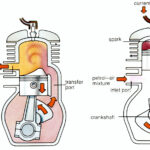Choosing the right size mountain bike is crucial for comfortable and efficient riding. While standover height and general size charts are helpful, understanding mountain bike geometry is key to finding your perfect fit. Geometry measurements dictate how a bike will handle and how your body will interact with it, directly impacting your riding experience. This guide breaks down the essential mountain bike geometry terms you need to know to determine what size mountain bike you need, moving beyond just frame size and into the nuances of bike fit.
Reach: Dialing in Your Cockpit
Reach is arguably the most important measurement when considering mountain bike size. It’s the horizontal distance from the bottom bracket to the center of the top of the head tube. Reach directly influences your cockpit length and riding posture when you’re standing, which is the dominant position for mountain biking.
- Too much reach: You’ll feel stretched out, putting excessive weight on your hands and limiting your ability to maneuver effectively. This can lead to discomfort and reduced control, especially on technical trails.
- Too little reach: The cockpit will feel cramped, making you too upright. This can lead to a loss of stability, particularly on descents, and can make it harder to weight the front wheel for traction on climbs.
Reach dictates your range of motion and how your weight is distributed on the bike. Finding the right reach is essential for a balanced, powerful, and comfortable riding position. When considering “What Size Mountain Bike Do I Need,” think about reach first to ensure the bike’s cockpit fits your body and riding style.
Stack: Fine-Tuning Handlebar Height
Stack is the vertical distance from the bottom bracket to the center of the top of the head tube. It primarily indicates handlebar height in relation to the bottom bracket and your saddle. While stack can be adjusted with headset spacers and handlebar rise, understanding the base stack measurement is crucial for determining the inherent handlebar height of a frame.
- Higher stack: Results in a more upright seated pedaling position and higher handlebars. This can be more comfortable for climbing and endurance riding, and preferred by riders with less flexibility.
- Lower stack: Creates a more aggressive, forward-leaning seated position with lower handlebars. This is often favored for racing and riders seeking maximum efficiency and front-end control, especially on descents.
Although reach takes precedence for mountain bike fit due to the emphasis on standing riding, stack is still vital for seated comfort and overall bike feel. Consider your flexibility and typical terrain when evaluating stack to determine the most suitable handlebar height for your riding needs and to better understand “what size mountain bike do I need” in terms of overall frame dimensions.
Head Tube Angle: Steering Dynamics Explained
The head tube angle is the angle between the bike’s head tube and the ground. This angle significantly impacts the bike’s steering and handling characteristics, especially concerning stability and responsiveness.
- Slack head angle (e.g., 65° or less): These angles are slacker or more “laid back.” They provide increased stability at high speeds and on steep downhill terrain. Slack head angles make the bike feel more confident when descending but can make steering feel slower and less responsive on flatter or uphill sections. You might need to lean forward more on climbs to keep the front wheel planted.
- Steep head angle (e.g., 70° or more): Steeper head angles offer quicker, more nimble steering, making the bike feel agile and responsive, especially on climbs and tighter trails. However, they can feel twitchier and less stable at high speeds and on steep descents.
Head tube angle is a key factor in determining a mountain bike’s intended use and overall handling. When thinking about “what size mountain bike do I need,” consider how head angle influences handling and whether it aligns with your riding style and the trails you ride. Different disciplines, like downhill versus cross-country, utilize vastly different head angles, impacting the overall size and feel of the bike.
Chainstay Length: Rear Wheel Positioning and Ride Feel
Chainstay length is the distance from the rear axle to the bottom bracket. This measurement greatly affects how the rear wheel is positioned relative to the rider and influences the bike’s playfulness and stability.
- Short chainstays: Position the rear wheel closer to the rider’s center of mass. This makes the bike feel more agile, easier to manual and wheelie, and quicker to change direction. Short chainstays are often preferred for playful riding styles and tighter, more technical trails. However, they can sometimes compromise stability at high speeds and on very steep climbs, potentially making the front end feel light.
- Long chainstays: Increase stability, especially at speed and on rough terrain. They improve climbing traction by keeping the front wheel planted and provide a more stable platform overall. Longer chainstays are often favored for enduro, downhill, and riders prioritizing stability and confidence on challenging terrain.
Chainstay length is a crucial element in the overall balance and feel of a mountain bike. When considering “what size mountain bike do I need,” think about how chainstay length contributes to the bike’s character and whether it matches your riding style and terrain preferences. It’s not just about frame size, but how the rear end of the bike interacts with your body.
Bottom Bracket Height: Cornering and Clearance Considerations
Bottom bracket height is the distance from the ground to the center of the bottom bracket. Some manufacturers also specify “bottom bracket drop,” which is the vertical distance between the wheel axles and the bottom bracket. Both measurements essentially describe how low the bottom bracket sits relative to the axles and the ground.
- Low bottom bracket height (or large bottom bracket drop): Lowers your center of gravity, enhancing cornering stability and making the bike feel planted in turns. It improves handling on berms and provides a confident, “in-the-bike” feel. The trade-off is reduced pedal clearance, increasing the risk of pedal strikes on rocks, roots, and other trail obstacles.
- High bottom bracket height (or small bottom bracket drop): Provides more pedal clearance, reducing pedal strikes and making it easier to pedal through technical terrain and over obstacles. However, it can raise your center of gravity, potentially making the bike feel slightly less stable in corners.
Bottom bracket height is a balance between cornering prowess and obstacle clearance. When considering “what size mountain bike do I need,” think about the type of trails you ride. Technical, rocky trails might necessitate more bottom bracket clearance, while smoother, flow trails might benefit from the enhanced cornering of a lower bottom bracket. This is another geometry aspect that contributes to the overall sizing considerations beyond just frame size.
Wheelbase: The Sum of its Parts
Wheelbase is the total distance between the front and rear axles. It’s a result of several geometry factors, including head tube angle, reach, and chainstay length. Wheelbase is a comprehensive measurement that summarizes the bike’s overall length and its impact on stability and maneuverability.
- Longer wheelbase: Increases stability, especially at high speeds and over rough terrain. Longer wheelbase bikes tend to track straighter and feel more composed on descents and in challenging conditions.
- Shorter wheelbase: Makes the bike more maneuverable and easier to handle in tight corners and switchbacks. Shorter wheelbase bikes are often preferred for agility and responsiveness on twisty trails.
Wheelbase is a good summary metric to consider after understanding the individual geometry components. When asking “what size mountain bike do I need,” wheelbase gives you an overall sense of the bike’s handling characteristics. Consider how wheelbase, influenced by reach, head angle, and chainstay, aligns with your riding style and terrain.
Conclusion: Test Riding is Still Key
Understanding these mountain bike geometry measurements is essential for making an informed decision about “what size mountain bike do I need.” While size charts provide a starting point, geometry figures offer a deeper insight into how a bike will fit and perform. By considering reach, stack, head tube angle, chainstay length, bottom bracket height, and wheelbase, you can better assess if a bike’s geometry suits your body proportions, riding style, and the trails you intend to ride.
However, remember that numbers on a chart can only tell you so much. There’s no substitute for test riding different bikes to feel how the geometry translates to real-world performance. A bike that looks perfect on paper might not feel right on the trail, and vice versa. Use this geometry knowledge as a powerful tool in your bike selection process, but always prioritize getting out and riding to find the mountain bike that truly fits and feels right for you. If possible, visit us at one of our locations for expert advice and to test ride a range of mountain bikes.


